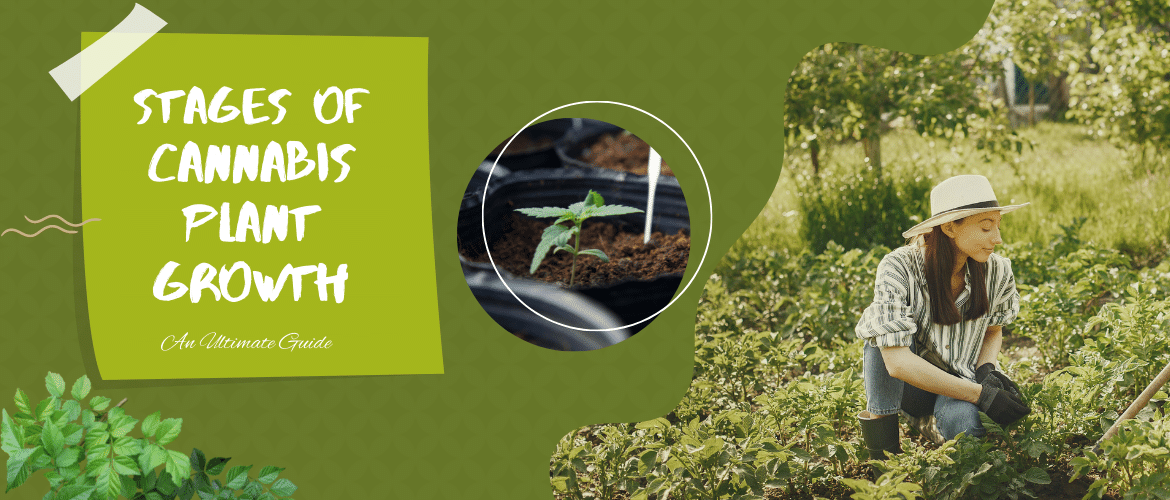
Cannabis plants go through a number of phases as they develop and mature, and each stage demands a specific quantity of light, nutrients, and water.
Understanding these stages and how long each lasts is crucial to understand what your plant needs and when it requires it. Knowing where your cannabis plants are in their life cycles will help you decide when to prune, train, or trellis them and when to harvest them.
How long do you reckon it will take a marijuana plant to develop?
Generally, it takes 10 to 32 weeks, or roughly 3 to 8 months, for a weed plant to develop from seed to harvest. Things will go much quicker if you start with a clone or an auto-flower seed. The vegetative stage is the most unpredictable period in terms of how long it takes for the Cannabis plant growth — from the seedling phase through flowering.
You can force a weed plant to flower much faster when growing it indoors as opposed to outdoors. If the plant is small, you may only have to wait a few weeks until it flowers. On the other hand, if the plant is big, you might have to wait several weeks. When outdoor plants are at the mercy of seasonal changes, they will usually only start flowering in fall once the sun goes down for longer periods each day.
Growers who cultivate outdoors can manage the flowering phase by using light deprivation methods.
Marijuana cultivation can be divided into four major growth stages, from seed to harvest:
Germination (3-10 days)
Seedling (2-3 weeks)
Vegetative (3-16 weeks)
Flowering (8-11 weeks)
1- Germination:
The seed stage is the first of the three marijuana plant stages. An ideal cannabis seed is hard, dry, and light to dark brown. On the other hand, an undeveloped or immature seed is generally squishy and green or white–meaning it probably won’t germinate.
When your seed has germinated and sprouted, it’s ready to be planted in a growing medium, such as soil. The tap root will extend downward while the seedling’s stem will expand upward.
Two rounded cotyledon leaves will emerge from the stem as the plant expands from its protective casing. These initial leaves are charged with absorbing sunlight so that the vegetation may flourish healthily and firmly.
Your cannabis plant will become a seedling when the first fan leaves arise, and you’ll be able to see this once the roots have developed.
Is there a way to make seeds sprout faster?
No. Cannabis seeds are fragile and don’t like to be relocated. They require a temperature range that doesn’t change much and not too much water. We recommend leaving them in the soil once you’ve planted them.
Sowing on clover can be effective because it increases the germination rate of most seeds. However, you may get some duds that do not sprout. Allow them to work; assisting them might help them survive longer.
2- Seedling:
When your marijuana plant is still a seedling, you’ll likely observe it developing regular cannabis fan leaves. The seed will only produce leaves with one ridged blade in the beginning stages.
The leaves of a cannabis plant will develop more blades, or “fingers,” as the plant matures (3, 5, 7, etc.). A mature cannabis plant typically has between 5 and 7 blades per leaf. However, some plants may have more.
Cannabis seedlings are those that haven’t developed leaves with the full number of blades yet. A good seedling will have bright green fan leaves. It’s easy to overwater these guys since their roots are tiny, so be careful not to give it too much H2O.
The houseplant is now susceptible to disease and mold. Maintain a clean environment and keep an eye on any additional moisture. Be sure it gets enough of sunshine.
Even if you’re growing outside, many growers will start their seeds indoors under artificial light to assist them through this critical stage in marijuana development.
If you purchase a clone from a grower or breeder, it will be a seedling, allowing you to bypass the seed germination process.
Also Read How To Check Good And Bad Weed?
3- Vegetative:
Cannabis’s vegetative phase is where the plant really begins to grow, generally lasting 3-16 weeks. You’ve transplanted your plant into a larger container with roots and leaves developing quickly at this stage. This is also the time to start training or topping your plants.
As your plant develops, increase its watering schedule. When the plant is young, water should be close to the stalk. However, as it grows, roots will also grow outward. Soil water away from the stalk allows for stretched outroots that can absorb water more efficiently.
Vegetative plants require nutrients in the soil. At this point, please give them a high amount of nitrogen.
4- Flowering:
The final stage of cannabis plant growth is the blooming stage. This is when cannabis plants begin to produce resinous buds, and your efforts will be rewarded. The majority of strains blossom in 8-9 weeks, but some sativas can take much longer.
As summer transitions to fall, the amount of daylight decreases and triggers flowering in outdoor plants. Indoor growers can create this same effect by reducing the light their marijuana plants receive from 18 hours to 12 hours each day.

